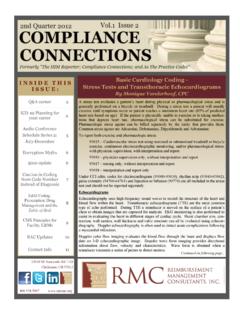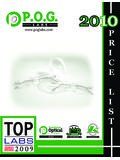Transcription of E V E R Y B O DY ’ S B U S I N E S S ... - who.int
1 E V E R Y B O D Y S B U S I N E S SS T R E N G T H E N I N G H E A LT H S Y S T E M S T O I M P R OV E H E A LT H O U T C O M E S W H O S F R A M E WO R K F O R AC T I O NWHO Library Cataloguing-in-Publication Data : Everybody business : strengthening health systems to improve health outcomes : WHO s framework for action. of health care - trends. systems plans. assessment (health care). 4. Health policy. Health 978 92 4 159607 7 (NLM classification: W ) World Health Organization 2007 All rights reserved.
2 Publications of the World Health Organization can be obtained from WHO Press, World Health Organization, 20 Avenue Appia, 1211 Geneva 27, Switzerland (tel.: +41 22 791 3264; fax: +41 22 791 4857; e-mail: Requests for permission to reproduce or translate WHO publications whether for sale or for noncommercial distribution should be addressed to WHO Press, at the above address (fax: +41 22 791 4806; e-mail: The designations employed and the presentation of the material in this publication do not imply the expression of any opinion whatsoever on the part of the World Health Organization concerning the legal status of any country, territory, city or area or of its authorities, or concerning the delimitation of its frontiers or boundaries.))
3 Dotted lines on maps represent approximate border lines for which there may not yet be full mention of specific companies or of certain manufacturers products does not imply that they are endorsed or recommended by the World Health Organization in preference to others of a similar nature that are not mentioned. Errors and omissions excepted, the names of proprietary products are distinguished by initial capital reasonable precautions have been taken by the World Health Organization to verify the information contained in this publication.
4 However, the published material is being distributed without warranty of any kind, either expressed or implied. The responsibility for the interpretation and use of the material lies with the reader. In no event shall the World Health Organization be liable for damages arising from its use. Printed by the WHO Document Production Services, Geneva, SwitzerlandC O N T E N T SL I S T O F A B B R E V I A T I O N S iiF O R E W O R D iiiE X E C U T I V E S U M M A R Y vI N T R O D U C T I O N 1 Objectives 1 Health system basics 2 H E A L T H S Y S T E M S C H A L L E N G E S A N D O P P O R T U N I T I E S 7 Managing multiple objectives and competing demands 7A significant increase in funding for health 8 Scaling-up is not just about increasing spending 8 The health systems agenda is not static 10 Development partners have their impact on health systems 11W H O
5 S R E S P O N S E T O H E A L T H S Y S T E M S C H A L L E N G E S 13A. A single framework with six building blocks and priorities 14B. Health systems and programmes: getting results 26C. A more effective role for WHO at country level 28D. The role of WHO in the international health systems agenda 31I M P L I C A T I O N S F O R T H E W A Y W H O W O R K S 35 New ways of working across the Organization 35 Enhancing staff competencies and capacity 36 Strengthen WHO s convening role, and role in health system partnerships 37 Next Steps 37 Annex 1 W H O S C O R E F U N C T I O N S A N D M E D I U M - T E R M S T R A T E G I C O B J E C T I V E S 38 Annex 2 R E F E R E N C E S 39 Annex 3 U S E F U L W E B L I N K S 44E V E R Y B O D Y S B U S I N E S S S S T R E N G T H E N I N G H E A L T H S Y S T E M S T O I M P R O V E H E A L T H O U T C O M E SiiiE V E R Y B O D Y S B U S I N E S S S S T R E N G T H E N I N G H E A L T H S Y S T E M S T O I M P R
6 O V E H E A L T H O U T C O M E SL I S T O F A B B R E V I A T I O N SAC R O N Y M F U L L T I T L EAU African UnionCCS WHO Country Cooperation StrategiesEURO WHO, Regional Office for EuropeGATS General Agreement Trade in ServicesGAVI Global Alliance on Vaccines InitiativeGAVI-HSS GAVI Health System StrengtheningGDP Gross Domestic ProductGHPs Global Health PartnershipsGOARN Global Outbreak And Response NetworkHIV/AIDS Human Immunodeficiency Virus / Acquired Immunodeficiency SyndromeHSAN Health Systems Action NetworkIMAI Integrated Management of Adult IllnessIMCI Integrated Management of Child IllnessLHW Lady Health WorkerMDG Millennium Development GoalMOH
7 Ministry of HealthMTSP Medium-Term Strategic PlanNEPAD New Partnership for Africa s DevelopmentNGO Non-Governmental OrganizationOECD Organisation for Economic Co-operation and DevelopmentSARS Severe Acute Respiratory SyndromeTB TuberculosisTTR Treat, Train and Retain initiativeUN United NationsUNITAID International Drug Purchasing FacilityWHO World Health OrganizationE V E R Y B O D Y S B U S I N E S S S S T R E N G T H E N I N G H E A L T H S Y S T E M S T O I M P R O V E H E A L T H O U T C O M E SiiiF O R E W O R DThe strengthening of health systems is one of six items on my Agenda for WHO.
8 The strategic importance of Strengthening Health Systems is absolute. The world has never possessed such a sophisticated arsenal of interventions and technologies for curing disease and prolonging life. Yet the gaps in health outcomes continue to widen. Much of the ill health, disease, premature death, and suffering we see on such a large scale is needless, as effective and affordable interventions are available for prevention and treatment. The reality is straightforward. The power of existing interventions is not matched by the power of health systems to deliver them to those in greatest need, in a comprehensive way, and on an adequate Framework for Action addresses the urgent need to improve the performance of health systems.
9 It is issued at the midpoint in the countdown to 2015, the year given so much significance and promise by the Millennium Declaration and its Goals. On present trends, the health-related Goals are the least likely to be met, despite the availability of powerful drugs, vaccines and other tools to support their attainment. The best measure of a health system s performance is its impact on health outcomes. International consensus is growing: without urgent improvements in the performance of health systems, the world will fail to meet the health-related Goals.
10 As just one example, the number of maternal deaths has stayed stubbornly high despite more than two decades of efforts. This number will not fall significantly until more women have access to skilled attendants at birth and to emergency obstetric health systems are highly context-specific, there is no single set of best practices that can be put forward as a model for improved performance. But health systems that function well have certain shared characteristics. They have procurement and distribution systems that actually deliver interventions to those in need.

















